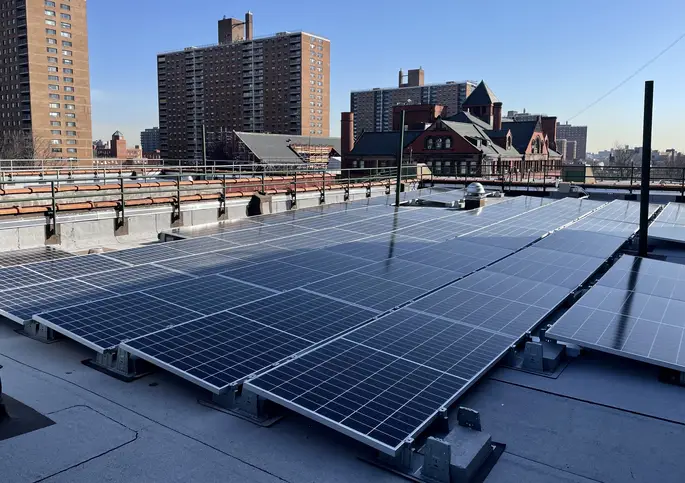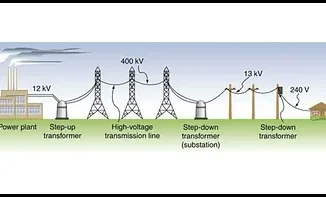
New York City has pledged to reach 1,000 megawatts of solar energy by 2030 — enough energy to power 250,000 homes, according to the Mayor’s Office of Environmental Justice. But state data shows that its current pace of installation will land short of that goal, leaving officials and advocates looking for ways to break down barriers to installation.
“It’s the right kind of ambition that we need, but we’re only a third of the way there,” said Louise Yeung, chief climate officer at the city comptroller’s office. “We need a different response to dramatically accelerate solar adoption among other kinds of renewable energy strategies in order to meet our climate goals.”
The slow pace isn’t due to lack of demand from New Yorkers – and, in recent years, has steadily increased. Brooklyn-based company Sunkeeper Solar has been installing solar panels on the city’s roofs since 2019, regularly completing several dozen projects in a year. But in recent months, Henry Hatch, the company’s director of origination, said the pace of installation has ballooned.
“We’re ramping up, and everybody in the city at least — our competitors and contemporaries — are very busy as well,” Hatch said last month, standing on a rooftop of a 24-unit apartment building in Clinton Hill surrounded by dozens of newly installed solar panels. The panels will produce around 4,250 kilowatt hours of energy per month and save the building $600-$650 on monthly energy bills once complete. This is one of over 4,500 projects currently underway to turn solar rays into energy across the five boroughs, according to state data.
But the recent uptick needs a boost if New York City wants to achieve its 2030 target. The issue has also become more pressing as the city lags behind the rest of the state in meeting the energy goals laid out in the state climate law, which passed in 2020. It requires that 70% of the state’s energy come from renewable sources by 2030. New York City continues to have the dirtiest power grid in the state, with nearly 90% of its energy currently made up of fossil fuels.
Now, the comptroller, the Department of City Planning and city lawmakers are separately looking to streamline the installation process and rapidly expand the pace of solar installations. Though each proposal is different, the core motivation remains the same: Curbing New York City’s greenhouse gas emissions — which trap heat in the atmosphere and contribute to climate change.
More energy must come from renewable sources, and scaling up the city’s solar energy generation will play a key role in that transition.
Cleaning a dirty grid
In the last two years, the city’s solar generation capacity has steadily grown as new state and local incentives have taken effect. But hurdles in the installation process and financing challenges mean that building owners still struggle to get projects off the ground, Yeung said.
Getting approval for a project can be slow, and New Yorkers pay thousands of dollars for the costs of installations, which can range from $15,000 to $30,000 for residential buildings.
“You still have a lot of challenging permitting,” Yeung said. “You still need to put up a fair amount of money in the beginning in order to even be able to afford or finance solar installations.”

A team from Sunkeeper Solar, a Brooklyn-based solar installation company, finishes connecting new rooftop solar panels to a building’s energy supply.
The state’s solar tax credit covers 25% of the cost of a solar installation, up to $5,000, and the federal tax credit is worth 30% of the installation cost. This means that solar installations are increasingly economical for building owners — and often pay for themselves in a matter of years through the eventual saving on energy costs. But not every homeowner is able to front the cash, nor do all have the time to prioritize solar projects.
“Even with the many good incentives that we have at the city, state and federal level, that’s a pretty big challenge,” Yeung said. “You also have to serve as a project manager, developer, financer — you have to wear many hats and it can be quite elaborate to actually get solar on your roof.”
Building owners make the call about whether to install solar panels on their roofs. Many pay for these panels themselves, though some companies will lease a roof from an owner and take on the installation costs and sell the generated energy. Renters aren’t able to initiate solar installations but may be able to subscribe to community solar projects or be eligible for state solar energy credits on their utility bills.
The comptroller’s office has proposed a new program, called Public Solar NYC, that would have the city finance, install and own rooftop solar at no upfront cost to homeowners. Though the program is still under consideration by the mayor’s office, Yeung said she hopes conversations about how to reduce the overhead for solar installations will help move the city toward more rapid solar expansion and meet its renewable energy goals.
I talk to constituents every day who want to reduce their emissions…Yet our city makes it too complicated and cumbersome to make it happen.
And it’s not only cost that slows solar expansion across the five boroughs. Outdated regulations also contribute to the lag, according to Councilmember Lincoln Restler, who represents neighborhoods in northern Brooklyn.
“I talk to constituents every day who want to reduce their emissions, who want to help us achieve the renewable energy future that we are waiting for,” Restler said. “Yet our city makes it too complicated and cumbersome to make it happen.”
Last month, Restler introduced a bill to the City Council that would change the fire code to allow for more of a building’s roof to be used for solar projects. He said he hopes the bill will make such projects more appealing to building owners.
Separately, the department of city planning is looking to change some zoning laws to ease solar installations. Right now, laws limit solar panels’ height and rooftop coverage, which makes it difficult for projects to meet fire code and means solar panels aren’t always installed at the ideal angle for the sun. The new proposal would allow panels to extend higher above rooftops and enable more solar arrays to be built on top of parking spaces and in other areas around the city, according to Casey Berkovitz, the planning department’s press secretary.
The proposal would change regulations that were created at a time when solar technology was more limited, and when officials’ understanding of the climate crises was still nascent, Berkovitz said. “It updates them so that they are no longer obstacles to our climate goals,” he added.
Hurdles could remain
Advocates said these initiatives could help speed up solar installations, but more would still need to be done.
“There are tens of thousands of solar installations in the five boroughs, but it still is relatively rare,” said Noah Ginsburg, executive director of the New York Solar Energy Industries Association. Installing solar across the city presents unique challenges even outside the high costs, he added. Densely packed buildings make these construction projects often more complicated here than elsewhere across the country.
Yet, the recent progress demonstrates that further solar adoption is possible, he said, and that many building owners see the financial benefits as well as the environmental ones. He hopes to see these benefits extend to nonprofits and homeowners of modest means, who have low tax burdens and therefore do not benefit from current solar tax credits.

New solar panels on a rooftop in Clinton Hill will produce around 4,000 kilowatt hours of energy per month once the installation is complete.
“Solar is more affordable than it’s ever been,” Ginsburg said. “That being said, it’s not equally accessible and affordable for everyone.”



